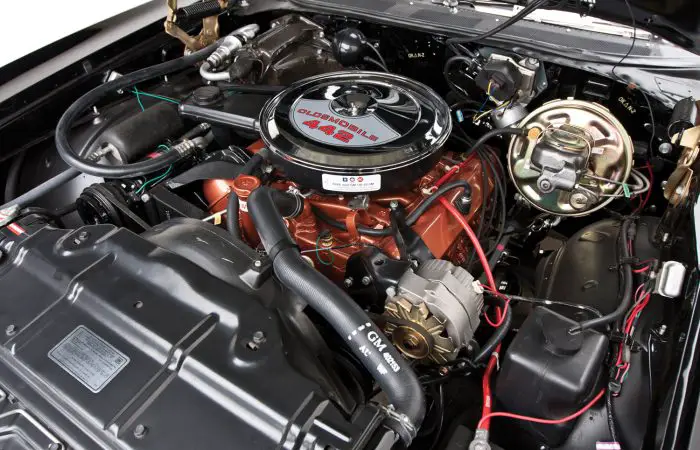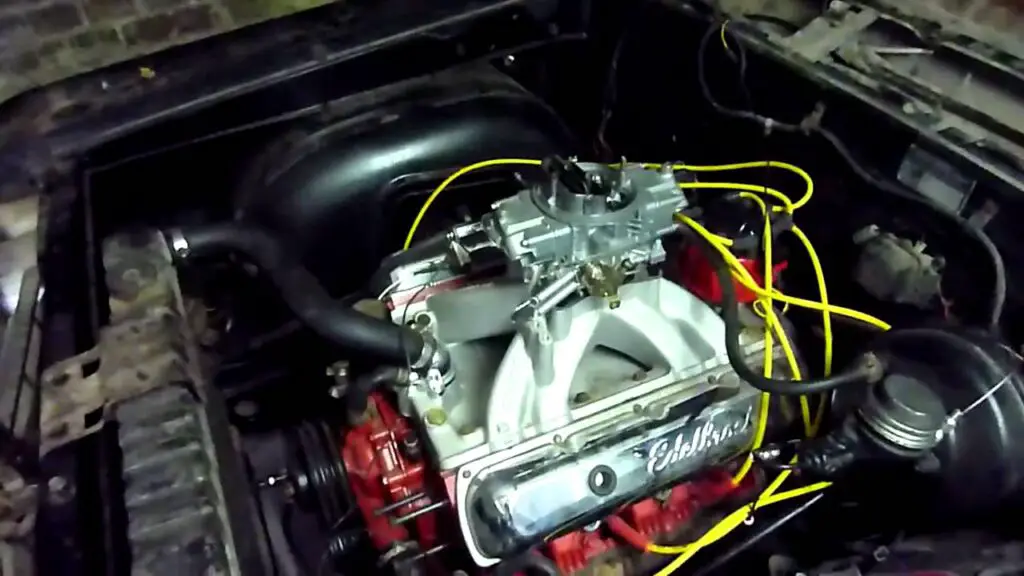The Oldsmobile 330 engine is a 5.4-liter V8 producing 230 horsepower and 360 lb-ft of torque. It features a 4.00-inch bore and 3.25-inch stroke, known for its smooth performance.
The Oldsmobile 330 engine, introduced in 1964, quickly became a cornerstone of Oldsmobile’s success during the 1960s. Known for its robust design and impressive performance, the 330 V8 was used in several key Oldsmobile models, setting the stage for the company’s dominance in the muscle car era.
In this blog post, we’ll dive into the detailed specs of the Oldsmobile 330 engine, including its performance, design features, and applications, and provide insight into its importance within the automotive world.

Contents
- 1 The Oldsmobile 330 Engine
- 2 Engine Specifications
- 3 Performance Variants of the Oldsmobile 330 Engine
- 4 Engine Design and Features
- 5 Applications of the Oldsmobile 330 Engine
- 6 Performance and Tuning Potential
- 7 Advantages of the Oldsmobile 330 Engine
- 8 Disadvantages of the Oldsmobile 330 Engine
- 9 Frequently Asked Questions
- 10 Conclusion
The Oldsmobile 330 Engine
The Oldsmobile 330 engine is a small-block V8 that was introduced as part of General Motors’ move toward more efficient and powerful engines in the mid-1960s. The 330 engine, replacing the outdated 394 Rocket V8, offered better fuel efficiency, reduced weight, and an improved power-to-weight ratio, all while maintaining impressive horsepower and torque numbers. It became the engine of choice in Oldsmobile’s muscle cars and mid-sized vehicles, especially when paired with the performance-focused 442 package.
In this post, we’ll examine the full specifications of the Oldsmobile 330 engine, its features, the performance variants, and its role in Oldsmobile models. Whether you’re an automotive enthusiast, a classic car owner, or simply curious about vintage engines, this guide provides all the essential details.
Engine Specifications
The Oldsmobile 330 engine specifications are as follows:
1. Basic Engine Details
- Engine Type: V8
- Displacement: 330 cubic inches (5.4 liters)
- Bore: 3.9385 inches (100 mm)
- Stroke: 3.385 inches (86 mm)
- Compression Ratio: The compression ratio ranged from 9.0:1 to 10.25:1, depending on the specific model and its performance tuning.
- Fuel System: Rochester 2-barrel or 4-barrel carburetors (depending on the performance version)
- Horsepower: Between 230 hp to 310 hp
- Torque: 325 lb-ft to 360 lb-ft
2. Material and Construction
- Block Material: Cast Iron
- Cylinder Heads: Cast Iron (varied based on model)
- Crankshaft: Forged Steel
- Valve Lifters: Hydraulic
3. Carburetion
- The standard 330 engine was equipped with a Rochester 2-barrel carburetor, while high-performance models (such as those in the 442 package) used a Rochester 4-barrel carburetor for improved fuel delivery and power output.
4. Engine Layout and Design
- Pushrod Configuration: Overhead valve (OHV)
- Camshaft Timing: Varies by the engine model, with more performance-focused versions using a slightly more aggressive camshaft profile for increased power.
Performance Variants of the Oldsmobile 330 Engine
The Oldsmobile 330 engine was available in several performance variants, with differences primarily revolving around the carburetor configuration, compression ratios, and camshaft timing.
1. Standard 330 V8
- Horsepower: 230 hp at 4,400 rpm
- Torque: 325 lb-ft at 2,400 rpm
- Compression Ratio: 9.0:1
This variant was used in basic models, offering a good balance of power and fuel efficiency, ideal for everyday driving.
2. High-Performance 330 V8
- Horsepower: 290 hp at 4,800 rpm
- Torque: 355 lb-ft at 2,800 rpm
- Compression Ratio: 10.25:1
The high-performance version of the 330 engine featured a 4-barrel carburetor and a higher compression ratio, offering better acceleration and top-end power, which made it an excellent choice for performance-oriented vehicles like the Oldsmobile 442.
3. 442 Performance Package
- Horsepower: 310 hp at 5,200 rpm
- Torque: 355 lb-ft at 3,600 rpm
- Compression Ratio: 10.25:1
The 442 was Oldsmobile’s flagship muscle car, and the 330 V8 engine in this configuration offered peak performance, making it one of the most potent versions of the engine. The 442 package also included handling and suspension upgrades to complement the engine’s raw power.
Engine Design and Features
The Oldsmobile 330 engine is a well-balanced V8 designed for both performance and durability. It incorporates several key features that contributed to its smooth operation and reliability during its era.
Crankshaft and Block
The Oldsmobile 330 engine was designed with a strong cast-iron block and a forged steel crankshaft. The use of forged steel in the crankshaft helped ensure that the engine could withstand the stresses of high-performance driving without risk of failure. Additionally, the crankshaft’s design allowed for smoother operation, contributing to better overall engine balance.
The engine’s 3.9385-inch bore and 3.385-inch stroke struck a balance between high-revving performance and low-end torque, making it versatile in various driving conditions. This made the 330 engine suitable for both street driving and more aggressive performance applications.
Cylinder Heads and Valvetrain
The cylinder heads on the 330 engine were designed to maximize airflow while maintaining efficiency. Early versions of the engine were equipped with either 70cc or 85cc combustion chambers, which influenced the engine’s compression ratio and overall performance.
The engine used a pushrod-operated valvetrain, with hydraulic lifters that reduced the need for regular maintenance. The hydraulic lifters ensured smooth operation of the engine, making it reliable for daily driving as well as high-performance applications.
Fuel System and Induction
The fuel system on the 330 engine varied depending on the model and performance package. The standard version of the engine was equipped with a Rochester 2-barrel carburetor, while the performance versions (including the 442 package) came with a Rochester 4-barrel carburetor. The 4-barrel carburetor allowed for a more efficient fuel-air mixture, resulting in better acceleration and higher top-end performance.
The engine’s intake manifold was designed to complement the carburetor setup, ensuring that the engine received a consistent flow of air and fuel. This setup was key to the engine’s smooth performance and fuel efficiency.

Applications of the Oldsmobile 330 Engine
The Oldsmobile 330 engine was used in several different models throughout the 1960s. Its versatility made it suitable for a wide range of vehicles, from performance cars to family sedans.
Oldsmobile Cutlass
The 330 engine was used in the 1964-1967 Oldsmobile Cutlass, which was one of Oldsmobile’s most popular models. The 330 was standard in many Cutlass models, and the 442 package, which offered the high-performance 330 V8, was a standout option for muscle car enthusiasts.
Oldsmobile F-85
The Oldsmobile F-85, introduced in 1961, also featured the 330 engine. This model was positioned as a compact car, but with the 330 V8 under the hood, it provided a performance boost over the four-cylinder and inline-six engine options. The 330 engine in the F-85 was available in both standard and performance configurations, allowing buyers to choose the level of power they desired.
Oldsmobile Delta 88 and Jetstar 88
The Delta 88 and Jetstar 88 were full-sized cars that could be equipped with the 330 engine. The engine offered smooth, reliable performance, and the Delta 88 became a popular family car in the 1960s, thanks in part to the efficiency and power of the 330 V8.
Performance and Tuning Potential
The Oldsmobile 330 engine was designed with performance in mind, and many enthusiasts found it to be a great platform for tuning and modifications. Because the engine’s internals were robust, it was common for people to increase its displacement by boring the engine block, which resulted in an engine capable of even higher performance levels.
Many enthusiasts would also replace the 330’s stock camshaft with a higher-performance version to boost horsepower. Additionally, upgrading the carburetor, intake manifold, and exhaust system could unlock even more power from the engine, making it a popular choice for hot rods and muscle car builds.
Advantages of the Oldsmobile 330 Engine
The Oldsmobile 330 engine offers several advantages, making it a popular choice for performance enthusiasts and classic car collectors alike. Its design emphasizes both power and durability, making it suitable for various vehicle applications.
- Durability: The 330 engine’s cast-iron block and forged steel crankshaft ensured that it was built to last, even under high-performance driving conditions.
- Performance: With up to 310 horsepower, the engine offered excellent performance for its time, particularly when paired with the 442 performance package.
- Tuning Potential: The engine was highly moddable, with enthusiasts regularly increasing its displacement and upgrading its components for additional power.
- Versatility: The 330 engine was used in a variety of Oldsmobile models, from compact cars like the F-85 to larger vehicles like the Delta 88.
Disadvantages of the Oldsmobile 330 Engine
While the Oldsmobile 330 engine was a reliable and powerful choice for its time, there are a few drawbacks that may limit its appeal for modern applications.
- Weight: The cast-iron block contributed to the engine’s overall weight, which affected the handling of vehicles equipped with the 330 V8.
- Fuel Economy: While the engine offered good power, it wasn’t the most fuel-efficient, especially in its higher-performance variants.
- Parts Availability: As the engine aged, sourcing replacement parts became more difficult, particularly for the high-performance versions of the engine.
Frequently Asked Questions
Here are some FAQs about the Oldsmobile 330 Engine –
1. What is the displacement of the Oldsmobile 330 engine?
The Oldsmobile 330 engine has a displacement of 330 cubic inches, or 5.4 liters.
2. How much horsepower does the Oldsmobile 330 engine produce?
The horsepower varies depending on the configuration, ranging from 230 hp in the standard version to 310 hp in the high-performance 442 package.
3. What cars did the Oldsmobile 330 engine come in?
The 330 engine was used in various Oldsmobile models, including the Cutlass, F-85, Jetstar 88, and Delta 88.
4. Can the Oldsmobile 330 engine be modified for more power?
Yes, the 330 engine is a popular choice for modifications. Tuning and component upgrades can increase its power significantly.
5. What are the main disadvantages of the Oldsmobile 330 engine?
The main disadvantages are its weight, which can affect vehicle handling, and its lower fuel efficiency, especially in the high-performance variants.
Conclusion
The Oldsmobile 330 engine was a remarkable piece of engineering in its time. With its robust build, versatile performance, and tuning potential, it became a cornerstone of Oldsmobile’s reputation for producing powerful yet reliable engines. From daily drivers to muscle cars, the 330 V8 offered something for a wide range of customers.
Despite some of its drawbacks, the Oldsmobile 330 remains an important engine in automotive history and continues to be cherished by classic car enthusiasts and restorers today.